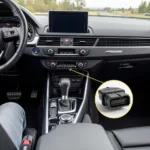Converting your vehicle’s wiring harness from OBD1 to OBD2 can seem like a daunting task, but with the right information and preparation, it’s a manageable project for the automotive enthusiast. This comprehensive guide will walk you through the process, explaining the why, when, and how of changing your wiring harness from OBD1 to OBD2.
Understanding the OBD Systems
Before diving into the conversion process, it’s essential to understand the differences between OBD1 and OBD2 systems. OBD stands for On-Board Diagnostics, and these systems are designed to monitor your vehicle’s emissions and performance.
OBD1, introduced in the late 1980s, was the first generation of standardized onboard diagnostics. It used a basic system of sensors and a single diagnostic connector to retrieve limited information about engine performance.
OBD2, implemented in 1996, brought significant improvements. It offered more comprehensive diagnostics, standardized diagnostic connectors, and real-time monitoring of emissions-related components.
Why Make the Switch?
While OBD1 systems served their purpose, they have limitations compared to their modern counterparts. Here are some compelling reasons to consider changing your wiring harness from OBD1 to OBD2:
- Improved Diagnostics: OBD2 offers more precise and detailed diagnostic information, making it easier to identify and address engine problems.
- Enhanced Emission Control: OBD2 systems provide real-time monitoring of emissions-related components, ensuring your vehicle meets modern emission standards.
- Wider Compatibility: OBD2 diagnostic tools are universally compatible, giving you more flexibility in choosing scanners and accessing diagnostic information.
When is a Wiring Harness Change Necessary?
A wiring harness change is often necessary when:
- Engine Swaps: Swapping an older engine with an OBD2-compliant one requires a corresponding wiring harness to ensure seamless integration.
- Upgrading to OBD2: Converting an older vehicle to benefit from OBD2’s advanced features requires a wiring harness change.
- Harness Damage: In cases of severe damage to the existing OBD1 wiring harness, replacing it with an OBD2 equivalent might be more cost-effective and efficient.
Evaluating the Conversion Process
Changing your wiring harness from OBD1 to OBD2 is a multi-step process that involves:
- Gathering Information: Determine the specific wiring harness compatible with your vehicle’s make, model, and year, along with the new OBD2 system you’re installing.
- Procurement: Purchase the necessary components, including the OBD2 wiring harness, any required sensors, and a compatible ECU (Engine Control Unit) if needed.
- Preparation: Disconnect the battery and remove any components obstructing access to the wiring harness, such as the air intake or battery tray.
- Removal: Carefully disconnect and label all connectors and sensors from the old OBD1 harness.
- Installation: Route the new OBD2 wiring harness following the manufacturer’s instructions. Connect the corresponding sensors and components.
- ECU Programming: If replacing the ECU, program it with your vehicle’s specific information to ensure proper communication and functionality.
- Testing: Reconnect the battery and thoroughly test all systems, including engine operation, emissions, and diagnostic communication.
Potential Challenges and Considerations
While changing your wiring harness from OBD1 to OBD2 offers significant benefits, it’s crucial to be aware of potential challenges:
- Wiring Complexity: Automotive wiring harnesses can be intricate. Meticulous attention to detail is crucial when disconnecting, labeling, and connecting wires to prevent errors and ensure proper functionality.
- Compatibility Issues: Selecting the correct wiring harness and components for your specific vehicle model and engine is paramount. Incompatibilities can lead to malfunctions and diagnostic errors.
- ECU Programming: Reprogramming or replacing the ECU can be a specialized task requiring specific tools and knowledge.
Expert Insights
“Many car enthusiasts underestimate the importance of a properly installed wiring harness,” says John Miller, a veteran automotive electrician with over 20 years of experience. “It’s the nervous system of your vehicle, and any mistake during installation can lead to a cascade of electrical gremlins.” He emphasizes the importance of consulting reliable wiring diagrams and, if in doubt, seeking professional assistance.
 Performing an OBD2 Diagnostic Scan
Performing an OBD2 Diagnostic Scan
Conclusion
Changing your wiring harness from OBD1 to OBD2 is an investment that enhances your vehicle’s diagnostics, emissions control, and overall performance. While it can be a challenging project, thorough research, meticulous execution, and, if necessary, professional guidance can make the conversion a success.
Remember, a properly functioning OBD2 system is essential for maintaining your vehicle’s health, performance, and compliance with modern emission standards.

